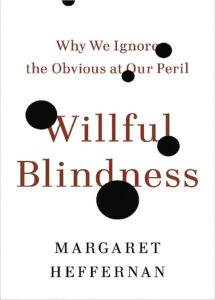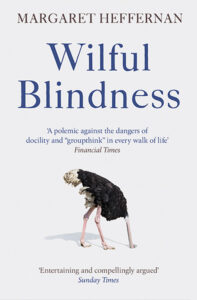I am a seeker of truth. Whatever it is and whatever the cost of knowing it, the absolute truth is paramount to me. This makes me rather intense and probably quite annoying but anything less than the truth feels like an unstable foundation to me. That’s why I love the sciences – physics and mathematics – super stable stuff.

What I have struggled with for years but particularly since 2020 is why other people seem perfectly content to ignore the truth. I’m not even talking about the cultural phenomenon of your truth and my truth (see my earlier blog post on this topic) but concrete facts across all walks of life that have huge implications when ignored. I was expressing this frustration to a doctor colleague at a conference recently and she recommended this wonderful book Willful Blindness by the multi-talented Margaret Heffernan.
First published in 2011 it is still incredibly relevant today and I think should be required reading for all high school seniors before we send them out into the world.
Each chapter takes a theme or environment and uses real life examples of how and why willful blindness occurs. For example, in personal relationships, the spouse who ignores signs of an affair, the parent who ignores signs of child abuse. In industrial safety situations, the layers of management looking to cut costs ignoring the signs of impending doom such as the BP oil explosion at the Texas City refinery, the Deepwater Horizon incident. The collapse of major banks and of Enron get due analysis as does government bureaucracy with the Pentagon Papers saga.
Ms. Heffernan also explores the limits of the mind such as chronic sleep deprivation and burnout as well as many aspects of the human condition. The common argument to be just following orders is another theme with comparisons made of not just the Third Reich and the military, but also junior doctors and nurses in hospitals, and layers of management in big companies. The culture inside these companies gets examined and implicated as does the bystander effect.
The book covers a couple of medical examples such as Alice Stewart, a physician in the 1950s who chose to study the incidence of childhood cancers and linked them to X-rays during pregnancy. With irrefutable evidence over a number of years and several published studies, the establishment refused to listen. Ms. Heffernan uses this example to explain the key idea which is cognitive dissonance – “the mental turmoil that is evoked when the mind tries to hold two entirely incompatible views”. In this case that X-rays are a useful wonder tool but that they also kill babies and small children. Asbestosis and cancer rates in a mining town is another medical example as well as experiments that track how doctors treat and diagnose conditions found to be based on the patient’s ability to pay, ie. that money drives decisions on appropriate medical treatment.
The last two chapters highlight some heroes who chose to speak up and speak out even when no one wanted to listen. And how everyone can learn to see better and avoid group think.
One of the most provocative sections addresses how we think technology is connecting us but “we delude ourselves that because so many words are exchanged – emails, notes and reports – somehow a great deal of communication must have taken place”. But in fact the considerable distances often involved particularly in complex multinational organizations, facilitate management blindness as you’re not seeing the consequences of your instructions. Another great quote “Technology can maintain relationships but it won’t build them”. Video and conference calls facilitate blindness to what’s really going on.

This insightful book has calmed my frustrations a little. It doesn’t solve the problem but it does provide a reasonable explanation of the phenomenon. Understanding and awareness is the beginning. Figuring out how to impact people suffering willful blindness is the next step. Two crucial habits to develop are: critical thinking and courage. A must for high-schoolers but everyone else too!
Check out the UK version of the book which has a great cover!
Related Content




Lou Harris
I’ve got to say Emma, I’m loving reading your blogs. Keep them coming. Very insightful, provocative and balanced. And, as you conclude in this article, courageous. Keep going!
Emma Tekstra
Thanks Lou! It definitely helps to get a bit of encouragement along the way!